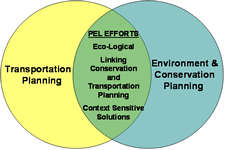PEL Background and Resources
Planning and Environmental Linkages (PEL) Program Goals
 The North Central Texas Council of Governments (NCTCOG) serves as the MPO for the Dallas-Fort Worth Metropolitan Planning Area (MPA). As an MPO, NCTCOG will strive to produce an enhanced Metropolitan Transportation Plan to serve the mobility needs of the region into the future while establishing priority environmental goals and strategies and promoting enhanced environmental stewardship during the planning process. Planning and environmental linkages involves coordination with resource and transportation planning agencies to integrate environmental considerations and community needs early in the planning process. Coordination also builds continuity between transportation planning and the NEPA process in advance of project implementation.
The North Central Texas Council of Governments (NCTCOG) serves as the MPO for the Dallas-Fort Worth Metropolitan Planning Area (MPA). As an MPO, NCTCOG will strive to produce an enhanced Metropolitan Transportation Plan to serve the mobility needs of the region into the future while establishing priority environmental goals and strategies and promoting enhanced environmental stewardship during the planning process. Planning and environmental linkages involves coordination with resource and transportation planning agencies to integrate environmental considerations and community needs early in the planning process. Coordination also builds continuity between transportation planning and the NEPA process in advance of project implementation.
Benefits
The MPO can achieve significant benefits by incorporating environmental and community values into transportation decisions early in planning and carrying these considerations through project development and delivery. The benefits of this approach include the following.
- Enhanced communication and information sharing
- Sharing of data and tools
- Integrated approach to conservation and transportation planning that incorporates an enhanced review of environmental impacts caused by transportation projects
- Expertise and knowledge from each side means more inclusive and sound decisions
- Visualization of transportation plan with environmental resources
- Decrease duplication of information and work
- Provide the public more timely implementation of transportation projects due to a streamlined environmental process
The Federal Highway Administration has created the Planning and Environmental Linkages Program to provide guidance and encourage incorporation of environmental, economic, and sustainability considerations early in the planning process.
Legislation Encouraging Environmental Considerations in Transportation Planning
 The Safe, Accountable, Flexible, Efficient Transportation Act: A Legacy for Users (SAFETEA-LU) passed on August 10, 2005, and included several provisions intended to enhance the consideration of environmental issues and impacts within the transportation planning process and encourage the use of the products from planning in the National Environmental Policy Act (NEPA) process. SAFETEA-LU has been superseded first by Moving Ahead for Progress in the 21st Century (MAP-21) in 2012, then by the current national transportation act, Fixing America’s Surface Transportation (FAST) Act in 2015. FAST Act expands provisions to include stormwater considerations in the metropolitan planning process.
The Safe, Accountable, Flexible, Efficient Transportation Act: A Legacy for Users (SAFETEA-LU) passed on August 10, 2005, and included several provisions intended to enhance the consideration of environmental issues and impacts within the transportation planning process and encourage the use of the products from planning in the National Environmental Policy Act (NEPA) process. SAFETEA-LU has been superseded first by Moving Ahead for Progress in the 21st Century (MAP-21) in 2012, then by the current national transportation act, Fixing America’s Surface Transportation (FAST) Act in 2015. FAST Act expands provisions to include stormwater considerations in the metropolitan planning process.
The aim of these provisions are to continually enhance the quality of the transportation planning process, while reducing the project delivery time and achieving better environmental outcomes. By incorporating environmental concerns earlier in the planning process and including all transportation stakeholders, the transportation planning process will be a more informed decision-making process.
Section 6001, Environmental Considerations in Planning, requires certain elements and activities to be included in the development of long-range transportation plans. These include but are not limited to the following.
- Consult with resource agencies, such as those responsible for land-use management, natural resources, environmental protection, conservation and historic preservation
- Considers environmental concerns in the long-range, statewide and metropolitan planning
- Discussion of potential environmental mitigation activities
- Develop participation plans for input on projects and identifies a process for stakeholder involvement
- Comparisons of resource maps and inventories to provide a visualization of proposed transportation strategies where practicable
Section 6002, Efficient Environmental Review for Project Decision Making, includes the following elements.
- Define an Environmental Review Process
- Involve participating agencies and the public in developing project purpose and need and a range of alternatives
- Make funding available for resource agencies to contribute to process improvements for activities that expedite and improve transportation planning and project delivery
